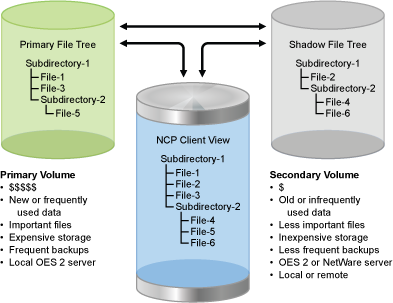1.1 Understanding Dynamic Storage Technology
Dynamic Storage Technology (DST) for OES 2 Linux is a feature of NCP Server that allows you to specify a shadow relationship between two volumes that form a shadow volume pair. The secondary directory tree structure, or secondary file tree, shadows the primary file tree.
IMPORTANT:Only NSS volumes are supported to be used for DST shadow volume pairs.
1.1.1 Merged View of the File Tree
Dynamic Storage Technology presents the directory trees on each volume in a merged view, as illustrated in Figure 1-1. The primary file tree and shadow file tree have the same directory structure, so that each directory appears in both locations as data is moved between the two volumes. The primary tree and the secondary tree are overlaid to create one virtual volume tree that is transparently presented to the users. When accessing files through the merged view, users are not aware of the actual physical location of the files. If the shadow relationship is removed, the secondary volume can once again function independently and normally.
Figure 1-1 User View of the File System Directory

An example of the merged view of the shadow volume is shown in Figure 1-1. When an NCP client lists files for Subdirectory-1, the user sees File-1, File-2, and File-3. File-1 and File-3 are stored in the primary file tree. File-2 is stored in the shadow file tree.
When a client creates new files, the files are automatically stored in the primary file tree. When files in the shadow file tree are modified, a configurable option allows the files to be moved to the primary file tree (default), or left in the shadow file tree.
For example, if your policy is to place newer files in the primary file tree and to place older files in the shadow file tree, you want an older file in the secondary file tree to move to primary file tree if the file’s content is modified. On the other hand, if you are placing files of one type (such as .doc and .ppt) in the primary area and files of a different type (such as.mp3 and .jpg) in the secondary area, you want files to stay where they are whenever they are modified.
When a new directory is created, it is created in the primary file tree. A configurable option allows the necessary branches of the tree to be created in the shadow file tree in one of two ways:
-
The new directory path is created as needed when policies are enforced to move files to the directory in the secondary location (the default)
-
The new directory path is created immediately in the secondary location, and files are moved to the directory as policies are enforced.
Performance is better when the directory branches are created only as needed.
When a directory is deleted, it is deleted in both areas. When a directory is renamed, it is renamed in both areas. The coordination of the file and directory management happens automatically so that the areas remain synchronized and have the same directory structure.
1.1.2 Merged View for User File Access
Dynamic Storage Technology supports a merged view via NCP for user file access. You can also install and configure one of the following OES Services on the DST host server to provide a merged view for CIFS user access:
-
Novell CIFS (in OES 2 SP3 Linux or later)
Use Novell CIFS with the primary NSS volume in the DST shadow volume pair, just as you would with a regular NSS volume.
-
Novell Samba
This SMB/CIFS solution requires FUSE and ShadowFS as described in Section 12.0, Using ShadowFS to Provide a Merged View for Novell Samba Users. Configure SMB/CIFS shares on the primary NSS volume.
Users access files by connecting to the primary volume. All file operations (such as read, write, rename, delete, and so on) can be performed whether a file resides on the primary or secondary location. Dynamic Storage Technology executes the transaction transparently for the user.
In general, transactions are executed wherever the file resides. Any file that requires a normal user-level action (copy, delete, and so on) is moved back to the primary for the action to take place, which simplifies the auditing requirements. Some transactions, such as a directory rename, occur in both file trees in order to keep the paths synchronized.
In OES 2 SP2 Linux and earlier, only NCP and the Novell Samba solution are supported for a merged view of user file access.
1.1.3 Local File Access
After you create the shadow relationship, the secondary volume is hidden to everyone but those users or applications that are authorized to view the local Linux file system, such as the root user. The only operations that are intended to take place directly on the secondary volume are backup, or “remove and archive.”
For example, backup administrators and system administrators with root user privileges on the server can see the primary file tree and the shadow file tree as separate and independent directories. Thus, backup tools can apply one backup policy to the primary volume location and apply a different backup policy to the secondary volume location.
1.1.4 File Systems
The primary area and the secondary area can each be located anywhere in the logical Linux directory tree that is available to the server. For example, the default location for NSS volumes is in the /media/nss/ directory, but DST can handle any mount point that you specify for your NSS volumes.
The primary volume and secondary volume must use the same file system. Only the NSS file system is supported at this time.
The primary and secondary volumes can be located on a local SCSI devices, Fibre Channel SAN devices, and iSCSI SAN devices. The device types and performance can differ between the primary and secondary devices, with the secondary volume typically being on the device with lower performance.
Clustering is supported with Novell Cluster Services.